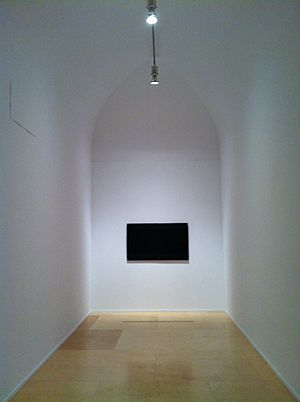Elena Asins facts for kids
Quick facts for kids
Elena Asins
|
|
|---|---|
| Born |
Elena Asins Rodriguez
2 March 1940 Madrid, Spain
|
| Died | 14 December 2015 Azpirotz, Navarra, Spain
|
| Nationality | Spanish |
| Education | Universidad Autonoma de Madrid, New School for Social Research, Columbia University |
| Known for | Painting, drawing, sculpture, poetry writing |
| Awards |
|
Elena Asins (born in Madrid on March 2, 1940 – died in Azpirotz, Navarra, on December 14, 2015) was a very important artist. She was also a writer, teacher, and art critic. Elena used computers and math to create her art. She was one of the first artists to mix computer science with art styles from the 1960s. These styles used simple shapes and lines. She was a pioneer in using computers to make art.
Life and Art Journey
Elena Asins began her art journey by exploring new ideas in Spain. This was during the last years of the Franco dictatorship. She joined groups that mixed different art forms. One group was the Cooperativa de Producción Artística y Artesana. Here, fine arts, poetry, languages, music, and architecture all worked together.
Another important group was the Centro de Cálculo (Computer Center) at the Universidad Autónoma de Madrid. This center was active from 1966 to 1982. Elena Asins was a leader in creating Computer art there.
Elena also traveled to study art and ideas in other places. She went to the University of Stuttgart in Germany. She also studied at Columbia University and the New School for Social Research in New York. In these places, she learned about many different topics. She studied how computers could be used in art. She also explored language theories and music. She even looked at old religious texts and philosophy.
Elena Asins once talked about her art. She said she often worked with black lines on white paper. Or she used white lines on black paper. She explained that she was looking for the basic structure of things. She wanted to find the foundation for all possible creations. She felt that colors did not give her this understanding. Instead, structure helped her organize the world. She believed that organizing elements creates beauty and reveals the logic of things.
Big Artworks
Since the 1980s, Elena Asins made many large sculptures for public spaces. You can see her works in places like the Museo al Aire Libre in Fuengirola, Malaga. There are also sculptures in Vitoria, Alava, and Berantevilla, Alava. In Zarautz, Gipuzkoa, she created a huge artwork called Canons 22. It stands right by the sea.
Art Collections
Elena Asins' art is kept in many important collections around the world. The Reina Sofia Museum in Madrid has the largest collection of her works. The museum received her art and personal papers in 2015.
Other public collections that have her art include:
- The Spanish Institute in New York
- Kulturboherde in Hamburg
- Institut Valencia d'Art Modern – IVAM in Valencia
- Museo de Bellas Artes de Alava in Vitoria
- Fundacion March in Madrid
- Archivo Lafuente in Santander
- Fundacion Chirivella Soriano in Valencia
- Cisneros Fontanals Art Foundation, CIFO in Miami, FL
Her art is also part of private collections.
See also
 In Spanish: Elena Asins para niños
In Spanish: Elena Asins para niños


